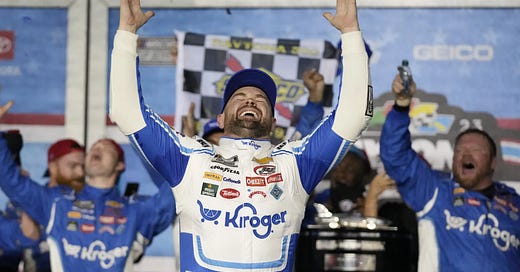Ricky Stenhouse Jr. Is One Of Daytona's Great Underdog Stories
Even by the Daytona 500's chaotic standards, 2023's winner was coming off an unheralded year.
With +4000 odds to win the 2023 Daytona 500, it’s fair to say few people (aside from some exceptions) saw Ricky Stenhouse Jr. pulling his No. 47 Kroger Chevy into victory lane after the Great American Race on Sunday. Stenhouse had risen all the way from 31st on the starting grid and never held the lead until a bold move to swoop into first place during overtime, but his first career win at the Daytona 500 ended up being indicative of the race’s last-man-standing theme.
That’s sort of fitting for Stenhouse, given the trajectory of his career. Early on, his back-to-back Nationwide Series championships seemed to augur great things at the Cup level, particularly since he would be racing alongside the likes of Carl Edwards and Greg Biffle with Roush Racing. But it took until Stenhouse’s fifth season (157 races) for him to win his first Cup Series race, and before this Sunday it had been an even longer streak of 199 consecutive races since his last win.
As a result, a signature Stenhouse victory that should have happened long ago turned into one of Daytona’s great out-of-nowhere triumphs.
I have a method that assigns points to NASCAR drivers in a more common-sense way than the official standings. The sport’s current scoring system is famously convoluted; even its traditional system, which awarded points based on finishes in a linear fashion, feels wrong on principle. (Is the difference between 1st and 10th really the same as the difference between 21st and 30th?) To remedy this, I’ve created a scoring system informed by the general point-payouts found in other motorsport series, mapped to a smooth curve where the winning driver always gets 100 points and any driver finishing 41st or lower always gets zero:
In any given season, the average driver earns about 22 to 26 points per race, depending on the typical field size. (It was 25.7 in 2022.) Stenhouse Jr., however, averaged just 16.2 points per race in 2022 — 37 percent fewer than the average driver. (In other words, he had a Pts+ — Adjusted Points per race, indexed to an average of 100 — of 63.) Among Daytona 500 winners since 1973, the first modern season for which we can calculate this stat, only Michael Waltrip in 2001 (51 Pts+) and Austin Cindric in 2022 (61 Pts+) were coming off seasons less productive than Stenhouse was a year ago.
And while Cindric was still a fresh-faced Cup Series sophomore (coming off a rookie season with just seven races at the highest level, compared with 162 career drives in the Trucks and Xfinity series combined), Stenhouse is more like Waltrip or 2021 winner Michael McDowell — a 30-something journeyman who wasn’t expecting to be in the winner’s circle pretty much anywhere, much less at the Super Bowl of auto racing.
Now, to be fair to Stenhouse, his JTG-Daugherty Racing team is looking to simply finish laps and run in the middle of the pack most weekends. And in those goals, Stenhouse has succeeded: he completed 89.8% of possible laps last season (the Cup Series average was 92.5%) and had an average running position of 19.4. He made more green-flag passes (101.6 per race) than the number of times he was passed (94.8). And though Stenhouse hasn’t had a teammate at all the past two seasons, he clearly outdrove Ryan Preece when the two were teammates in 2020 and 2021.
In other words, Stenhouse is a totally solid, if unspectacular, NASCAR driver. And maybe it’s the time for those racers to shine at Daytona. Of the “top” seven winners on the list above, four have won since 2018; additionally, three of the top four have won since 2021. Even by the standards of plate-racing, where the Big One can scramble even the most logical-seeming of fields, this has been a chaotic run at the Daytona 500. Who better to win that kind of race, then, except a guy nicknamed “Wrecky” Stenhouse Jr.?
Filed under: NASCAR







